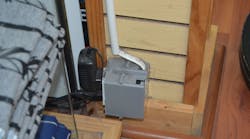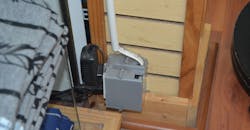Hint: Short sleeve
Scroll Down for the Answer
The sleeve for this NM cable seems to have come up a little short. I’m not sure why the installer chose to use this combination of equipment, but the end result is an installation that is not Code compliant.
An exception in Sec. 300.12 does permit short sections of raceways to be installed to support or protect cables without securing the raceway to the box. The exception in Sec. 300.18 allows essentially the same thing. The NM cable, however, needs to be secured to the box according to Sec. 314.17(C). The exception in 314.17(C) would allow the NM to be installed without securing it to this box, but the NM cable must then be fastened within 8 in. of the box instead of the 12 in. required by Sec. 334.30(A). I don’t see how installing NM cable in a PVC conduit sleeve could be considered “secured” or “fastened”.
Here are a few other items to consider. The unused opening of the box needs to be closed in accordance with Sec. 110.12(A). The missing receptacle cover is a violation of Sec. 314.25. Similarly, Sec. 406.6 requires receptacle faceplates to be installed so as to completely cover the box opening and seat against the mounting surface.





